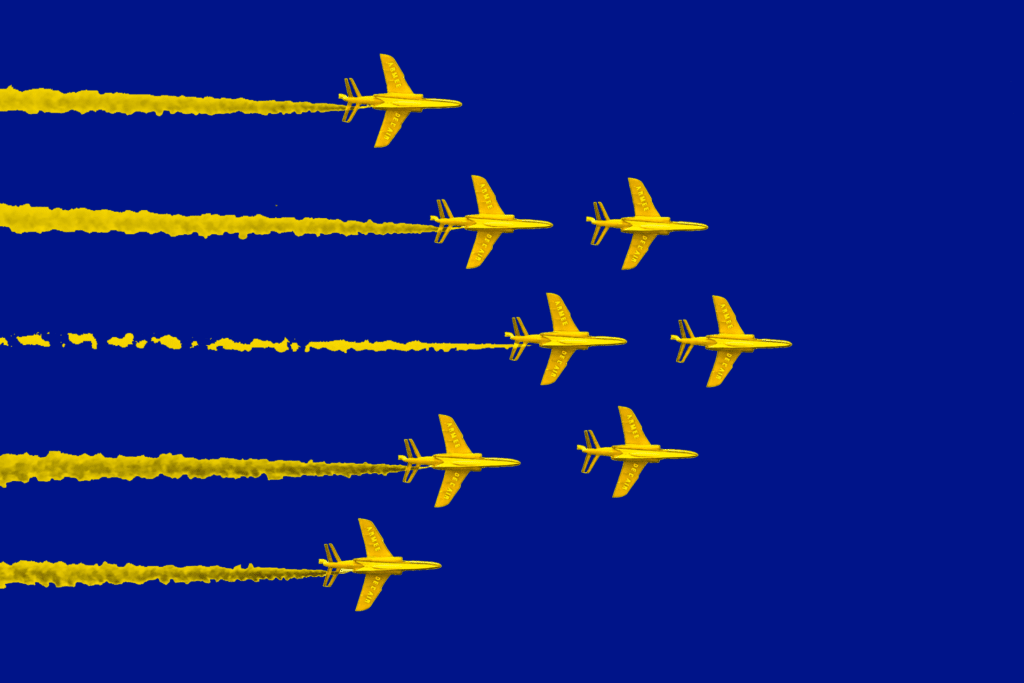Even in the face of Russian aggression, a nuclear ‘Eurodeterrent’ is still a bad idea
By Stephen J. Cimbala, Lawrence J. Korb | February 12, 2024
 Illustration by F. Diaz-Maurin, via Jastrow / Wikimedia Commons.
Illustration by F. Diaz-Maurin, via Jastrow / Wikimedia Commons.
Policy makers and national security experts are now seriously discussing the possible need for a European nuclear deterrent. For example, former German Foreign Minister Joschka Fischer, in an interview with the weekly Die Zeit in December 2023, supported the idea of a European nuclear deterrent. Other supporters of a European—or even a German—nuclear arsenal have contributed regularly to conservative German newspapers.
In 1975, the West German government stated that its ratification of the accession of the Federal Republic to the Nuclear Nonproliferation Treaty would not preclude an eventual nuclear deterrent within the framework of the European Union. The issue of a European nuclear deterrent also blends into the related question as to what role, if any, remains for so-called “tactical” or non-strategic nuclear weapons in NATO.[1]
There are several political and military arguments in favor of this proposal. But there are certainly also reasons for skepticism and concern that, considered together, add up to the conclusion that a Eurodeterrent continues to be a bad idea.[2]
Rationale for a Eurodeterrent. The first reason given for a European nuclear deterrent is the possibility that a future US president might not be as committed to NATO as his or her predecessors. This was a concern raised during the administration of President Donald Trump, whose open disparagement of European allies for allegedly insufficient financial contributions to NATO alliance security raised alarms from Brussels to Washington. Although Trump’s actual policies turned out to be less disruptive than his inflammatory rhetoric, his possible return to the White House in 2025 could reboot European doubts about US security commitments. These doubts could include concerns about the role of America’s nuclear umbrella in the deterrence of war in Europe.
A second reason for the renewed interest in a possible European nuclear deterrent is the war in Ukraine and the recurring threats by Russian President Vladimir Putin to resort to nuclear first use if needed to protect Russian security interests in that region.[3] Some Europeans who feel immediately threatened by Russian nuclear coercion, or even by the possibility of a Russian conventional military victory over Ukraine, might doubt the efficacy of America’s nuclear guarantee in the face of an increasingly confident Russia casting a larger shadow over the security of Eastern and Central European countries. Although Russia would still have its hands full of resistance and rebellion in Ukraine, even after having defenestrated the Zelensky government, European and American solidarity to further resist Russian diplomatic coercion supported by military power might weaken.
A third reason might be the growing nationalism in Europe and in the United States, spanning across the general public, leadership classes, and political office holders. The heady optimism about the North Atlantic security community that marked the Cold War and its immediate aftermath is now being challenged from many sides. Newer generations of voters show skepticism about the benefits of transnational and trans-Atlantic security and economic cooperation. There is also the growing significance among Europeans and Americans of identity politics, including doubts about the impact of foreign migration and so-called alarms over a dilution of national character. Parties of the far right are drawing increased strength in part from voters who feel denationalized by foreign influences and globalist agendas.
A fourth concern among some supporters of a European nuclear deterrent lies in doubts about the reliability of the US nuclear umbrella for the deterrence of war in Europe. NATO has only a small number of deployed nuclear weapons on European soil compared to Russia’s large inventory of nearly two thousand less-than-strategic or “tactical” nuclear weapons. Russia might be tempted under pessimistic conditions of unacceptable loss in conventional warfare, as they define “unacceptable,” to cross the nuclear threshold in any one of a number of ways.
Russia could engage in a demonstrative strike for coercive purposes with a low-yield nuclear weapon, which would do little immediate damage compared to the larger weapons that are prepositioned in its arsenal and raised to combat alert readiness in a crisis. Or Russia could employ a tactical nuclear weapon against a key Ukrainian or NATO military target to prepare the battlespace for a larger war. Would the United States and NATO risk responding with nuclear strikes of their own and thereby escalating the conflict to a larger nuclear war that might destroy much of Europe and ultimately the US homeland? Some military experts feel that the United States lacks a sufficient number of small yield nuclear weapons in its arsenal, compared to Russia’s larger inventories, and so would have lost escalation dominance across the spectrum of military options short of unrestricted nuclear warfare.
But more weapons do not necessarily equate to better deterrence. Deterrence remains centered in the mind of the deterree, not the deterrer. Guessing the threshold of conventional defeat beyond which Russia would feel obligated to resort to nuclear first use requires disciplined intelligence collection in real time, combined with mature judgment about Russia’s imminent priorities and risks.
Why it’s a bad idea. Despite these legitimate concerns about nuclear risks in Europe, it is not clear whether a European nuclear deterrent—either entirely separated from its American umbrella or somehow aligned with it for policy purposes—would enhance the credibility of deterrence or nuclear crisis stability. In fact, at least for four reasons, the opposite result is more probable.
First, legitimate concern should not give way to exaggerated fears of NATO or US abandonment of their political commitment to the deterrence of war in Europe or its defense if necessary. One might argue that NATO was more likely to wobble in the face of Russian intimidation when NATO was preoccupied with “out of the area” commitments in the Middle East and South Asia. Since 2014, however, when Russia annexed Crimea in a coup de main that caught the West asleep, NATO has witnessed a renaissance of awareness about its original mission to guarantee the peace in Europe. Russia’s war against Ukraine further aroused NATO to a unified political and military stance. However the conventional war between Russia and Ukraine turns out, NATO is stronger than it has ever been since the Cold War ended. The addition of Finland and the imminent addition of Sweden to NATO membership represent geostrategic fiascoes for Russia—and an outcome Putin and his advisors surely had not anticipated. NATO’s nuclear guarantee, supported by the United States’ nuclear umbrella, should never be doubted. Escalation is a two way street: Russia fears as much as European NATO countries that a nuclear first use could lead to a process that escapes the control of political leaderships playing at nuclear coercive diplomacy under unprecedented conditions of stress and uncertainty.
A second challenge for a European nuclear deterrent lies in its organization and operational shape, including the chain of command over a (presumably) multinational nuclear force. Something like this was attempted in the 1960s when several military planners and politicians put forward a proposal for a Multilateral Force (MLF) mixing personnel and weapons, including nuclear warheads, from several European powers. The problems of authoritative political control and operational management in such a force soon became evident and proved to be too challenging. Even short of an explicitly multinational force, a transnational European nuclear deterrent presents problems of political collaboration and military-operational command. One might propose that the United Kingdom and France, currently the only two nuclear weapons states among European NATO countries, move toward joint operations with respect to certain well defined contingencies and emergencies. Yet their political and military command and control systems would still have to remain separate for reasons of national sovereignty and military efficiency. In addition, because the United Kingdom is no longer in the European Union, a “Eurodeterrent” would not be under the political supervision of EU institutions and therefore be reduced to a bilateral cooperation. Another issue is that the European nuclear powers have very different delivery systems for nuclear weapons: The United Kingdom fields a fleet of ballistic missile submarines, while France also has land-based and carrier-based airborne delivery systems.
A third riposte to the idea of a European nuclear deterrent is that it might stimulate nuclear proliferation and ultimately lead to more nuclear weapons states, either in Europe or beyond. Reliance on the US nuclear guarantee has helped to prevent the spread of nuclear weapons not only in Europe, but also in Asia with respect to South Korea and Japan. If countries now start doubting the credibility of the US nuclear deterrent and feel immediately threatened by the growing capabilities of hostile neighbors, their leaders and publics might turn to national nuclear forces as a guarantor against aggression or nuclear coercion. This could be tempting because, based on the historical evidence, even a small number of nuclear weapons can be deterring to adversaries who might otherwise contemplate a conventional war against a state. If North Korea continues to menace South Korea with military threats, including nuclear ones, South Korea might reverse its prior disinterest in its own nuclear force. Japan too, if it feels threatened by a rising China, might reluctantly become more interested in a small but survivable force of sea-based nuclear missiles.
Fourth, the argument that the US nuclear force is insufficiently flexible for deterring or responding to nuclear coercion or nuclear first use deserves further scrutiny. The United States’ combatant commanders who operate the unified and specified commands in wartime are also responsible for planning against a range of threats across the spectrum of conventional war and nuclear deterrence. Flexibility and multiple options are built into these plans for every challenge, ranging from unconventional wars and coercive diplomacy to limited or large-scale conventional war to, if necessary, nuclear coercion or retaliation. Plans are scrubbed repeatedly and road-tested in near-realistic exercises.
In today’s world of high tech competition among major powers, neither the United States nor any other aspiring military can afford to rest on dated plans, aging technology, or roseate assumptions about the likelihood of wars. Surprises are inevitable: preparation and agility are the hallmarks of superior military performance. As Dwight D. Eisenhower famously said: “Plans are worthless, but planning is everything.”
Notes
[1] There is a considerable history of Cold War and post-Cold War policy debates here. See, for example: Richard Weitz, “The Historical Context,” pp. 3-12, and Paul Schulte, “Tactical Nuclear Weapons in NATO and Beyond: A Historical and Thematic Examination,” both in Tom Nichols, Douglas Stuart and Jeffrey D. McCausland, eds., Tactical Nuclear Weapons and NATO (Carlisle, Pa.: US Army War College, Strategic Studies Institute, April 2012). See also: George Perkovich, Nuclear Weapons in Germany: Broaden and Deepen the Debate (Washington, D.C.: Carnegie Endowment for International Peace, February, 2010).
[2] An interesting commentary on this topic appears in: Michael Ruhle, “German Musings About a European Nuclear Deterrent,” (Fairfax, Va.: National Institute for Public Policy, Information Series, January 3, 2024).
[3] See also Dmitri (Dima) Adamsky, The Russian Way of Deterrence: Strategic Culture, Coercion, and War (Stanford, CA: Stanford University Press, 2024), pp. 106-110.
Together, we make the world safer.
The Bulletin elevates expert voices above the noise. But as an independent nonprofit organization, our operations depend on the support of readers like you. Help us continue to deliver quality journalism that holds leaders accountable. Your support of our work at any level is important. In return, we promise our coverage will be understandable, influential, vigilant, solution-oriented, and fair-minded. Together we can make a difference.
Keywords: European security, NATO, Russia, US security guarantee, United States, nuclear deterrence, nuclear weapons in Europe
Topics: Nuclear Weapons
















So we the U.K should rely on the U.S.A. who recently and right now are looking like walking away having made promises. The U.K. should have a completely independent nuclear deterrent with limited cooperation with France.
As a cold war warrior it was my hope after the USSR imploded and China “was our friend” there would be little need for an immediate retaliatory nuclear arsenal. However, the last few years have me rethinking this. With Putin’s nuclear saber rattling and a possible trump second term with his dismissal of staying in or supporting NATO especially if they don’t pay up along with his green light to Putin to “do what the hell he wants” to those who don’t, Europe should not depend on US (us) for defence or nuclear deterrence in the face of Putin’s aggression.… Read more »
Very informative and thought-provoking analysis addressing a topical theme currently troubling due to a serious destabilization of the European security notably since the Russian invasion of Ukraine.Admittedly with this new geopolitical environment exacerbated since Trump’s blackmail to quit NATO and remove the US nuclear umbrella,europeans scared ahead of a ominous Russian encroachment to their territory,started eyeing to set up a European defense,bolstered by a French nuclear deterrent particularly since Emmanuel Macron proposed a French style extended nuclear deterrence in February 2020.If the arguments raised by the authors in favor of a”Eurodeterrent”are evidently convincing ,in return the reasons put forward and… Read more »